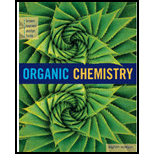
Concept explainers
(a)
Interpretation:
Synthesis of benzoic acid has to be shown.
Concept Introduction:
Benzoic acid can be synthesized from ethyl benzene using
(b)
Interpretation:
Synthesis of 1-bromo-1-phenylethane has to be shown.
Concept Introduction:
1-bromo-1-phenylethane can be synthesized using the reagents
(c)
Interpretation:
Synthesis of styrene has to be shown.
Concept Introduction:
The reagent used for the conversion of 1-bromo-1-phenylethane to styrene is
(d)
Interpretation:
Synthesis of 1-phenylethanol has to be shown.
Concept Introduction:
1-phenyl ethanol can be synthesized from styrene by the addition of water in acidic medium.
(e)
Interpretation:
Synthesis of acetophenone has to be shown.
Concept Introduction:
Acetophenone can be synthesized from benzene and benzene can be synthesized from benzoic acid. When
(f)
Interpretation:
Synthesis of 2-phenylethanol has to be shown.
Concept Introduction:
2-phenylethanol can be synthesized from styrene through hydroboration oxidation reaction.
(g)
Interpretation:
Synthesis of phenyl acetaldehyde has to be shown.
Concept Introduction:
phenyl acetaldehyde can be synthesized from styrene.
The reagent titanosilicate and hydrogen peroxide enhance the ethylene epoxidation reaction.
Al-SBA-15 is an aluminosilicate compound having mesoporous structure. It helps in isomerization of
(h)
Interpretation:
Synthesis of 2-phenylacetic acid has to be shown.
Concept Introduction:
The ester formed during this reaction is treated with
(i)
Interpretation:
Synthesis of 1,2-dibromo-1-phenylethane has to be shown.
Concept Introduction:
1,2-dibromo-1-phenylethane can be synthesized from styrene through bromination reaction.
(j)
Interpretation:
Synthesis of phenylethyne has to be shown.
Concept Introduction:
phenylethyne can be synthesized from 1,2-dibromo-1-phenylethane. The reagent used is sodium amide in liquid ammonia cause dehydrohalogenation.
(k)
Interpretation:
Synthesis of 1-phenyl-4-penten-1-yne has to be shown.
Concept Introduction:
1-phenyl-4-penten-1-yne can be prepared from phenylethyne and prop-2-en-1-ol. Carbon-carbon coupling will occur by using these reagents.
(l)
Interpretation:
Synthesis of 1-phenyloctyne has to be shown.
Concept Introduction:
1-phenyloctyne can be synthesized from phenylethyne through two steps. In the first step phenylethyne treated with Grignard reagent to get 1-phenylethyne magnesium bromide which then react with hexyl iodide in second step to give 1-phenyloctyne.
(m)
Interpretation:
Concept Introduction:
(n)
Interpretation:
Concept Introduction:
Trending nowThis is a popular solution!

Chapter 21 Solutions
BNDL: ACP ORGANIC CHEMISTRY:CH EM 231(W/ACCESS CARD)
- please provide the structure for this problem, thank youarrow_forwardpresented by Morallen Lig Intermine the hand product for the given mution by adding atoms, bonds, nonhonding diarion panda скуль Step 3: Comp the draw the product Step 2: Agama workup Compithe 429 ملولةarrow_forwardReaction A 0,0arrow_forward
- presented by Morillon Leaning Predict the organic product for the min кусур HSC Adithane carved arnown to come than that to the condon slchroruis in acid in in aquishri with ноюarrow_forward6.15PM Sun Mar 30 K Draw the major product of this reaction. Include any relevant stereochemistry. Ignore inorganic byproducts. Problem 1 of O H [PhзPCH2CH3]*C|¯ NaH Drawing > Q Atoms, Bonds and Draw or tap a nearrow_forward8:17 PM Sun Mar 30 Draw the major product of this reaction. Ignore inorganic byproducts. HSCH2CH2CH2SH, BF3 Probler Drawing Ato Bonds Clarrow_forward
- Name the major organic product of the following action of 4-chloro-4-methyl-1-pentanol in neutral pollution 10+ Now the product. The product has a molecular formula f b. In a singly hain, the starting, material again converts into a secule with the molecular kormula CIO. but with comply Draw the major organic structure inhalationarrow_forwardMacmillan Learning Alcohols can be oxidized by chromic acid derivatives. One such reagent is pyridinium chlorochromate, (C,H,NH*)(CICTO3), commonly known as PCC. Draw the proposed (neutral) intermediate and the organic product in the oxidation of 1-butanol by PCC when carried out in an anhydrous solvent such as CH₂C₁₂. PCC Intermediate OH CH2Cl2 Draw the intermediate. Select Draw Templates More с H Cr о Product Draw the product. Erase Select Draw Templates More H о Erasearrow_forwardIf I have 1-bromopropene, to obtain compound A, I have to add NaOH and another compound. Indicate which compound that would be. A C6H5 CH3arrow_forward
 Organic ChemistryChemistryISBN:9781305580350Author:William H. Brown, Brent L. Iverson, Eric Anslyn, Christopher S. FootePublisher:Cengage Learning
Organic ChemistryChemistryISBN:9781305580350Author:William H. Brown, Brent L. Iverson, Eric Anslyn, Christopher S. FootePublisher:Cengage Learning

